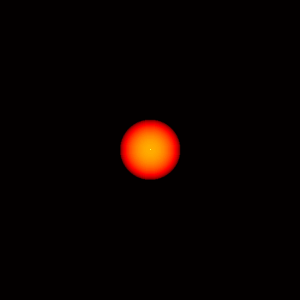The Life of Stars
What is a star?
This description may not be typical, but it explains things in a nutshell:
A star is
a continuous (and eventually doomed) battle with the inexorable force
of gravity. From the moment an interstellar cloud of gas and dust begins
to collapse under its own gravitational forces, it is doomed to one day
become a cold, dense, degenerate object like a white dwarf, a neutron
star, or possibly, if it's massive enough, even a black hole.
Every stage of a star's life represents a pause in this battle, as the
star finds some energy source which can temporarily halt its inevitable
collapse.
Young stellar objects
A star begins its life as part of the interstellar medium, usually as
a dense core in a giant molecular cloud. If something (like a nearby
supernova or a spiral density wave) can compress this cloud core some,
it will begin to collapse under its own gravity. Most of the mass will
quickly settle in the center of the cloud core while the envelope slowly
falls inward. At this stage, astronomers refer to the source as a
protostar. Because of its very cold temperature, astronomers must look
in the far infrared or at millimeter wavelengths to see it. At visual
wavelengths, protostars are completely dark.
Protostars continue to contract gravitationally while material
continues to accrete onto their surface. As they contract, their
temperature rises, making them visible first in the infrared and
eventually as star-like objects in the visual. Usually, these young
stars are embedded within the clouds from which they formed, and
they are often obscured from view.
Very massive stars can actually ionize the dust cloud around them,
producing spectacular nebulae like the Great Nebula in Orion or
the Eagle Nebula in Serpens. For some images from the Hubble
Space Telescope, go to the page on the birth
of stars (There are lots of pretty pictures here).
The main sequence
 |
Eventually the interior of the star gets so hot, thermo-nuclear
fusion reactions begin. These reactions produce tremendous amounts
of energy, halting the collapse process and allowing the star to
settle onto what is called the main sequence. Main sequence stars
provide their energy by fusing hydrogen atoms together to produce
helium.
The more massive a star is, the more energy it requires
to counteract its own gravity. As a consequence, very massive stars
burn the available hydrogen in their cores much more quickly than
low-mass stars. The more massive a star is, the shorter its life
on the main sequence will be. Stars with the mass of the Sun will
last on the main sequence about 9 billion years. Very massive stars,
like those in the Trapezium in Orion, will only last a million years
or less. Low-mass stars can survive for 100 billion years or more.
|
Red giants
 |
When all of the hydrogen in the core of a star has been converted to
helium, there is nothing left to prevent the core from collapsing
under its own gravity. Hydrogen to helium fusion continues in a
shell around this core, and as the core contracts, the temperature
increases. As the temperature increases, the luminosity of the star
increases, in some cases by a factor of 1000 or more. This extra
energy production will cause the outer layers of the star to expand,
even while the core is collapsing. In this bizarre geometry, even
though the interior temperature is far hotter than it was on the
main sequence, the outer layers expand and cool, producing a red giant.
|
The helium-burning main sequence
 |
Eventually, the temperatures in the stellar core get so high, helium
fusion can occur. The star has now found a new energy source to hold
itself up, although it won't last anywhere near as long as the
hydrogen-burning main sequence. The star settles down, decreasing
in brightness and contracting. |
The asymptotic giant branch
 |
When the star exhausts its supply of helium in the core, it repeats
the process that sent it up the red giant branch. The core begins
to contract and heat up again, and the envelope expands and reddens,
getting even larger than before. When the Sun reaches this phase,
its radius will extend past Earth's orbit. Not only will Earth be
cooked, but it will actually be swallowed up by the Sun! The
interior of a star on the asymptotic giant branch has several layers.
Around the inert (but toasty) core, there's a thin shell of helium
fusion. Around this an inert shell of helium (the temperature isn't
high enough to allow helium fusion), and around this a layer where
hydrogen fuses into helium.
This is not a very stable configuration, and astrophysicists
have been able to show that stars on the asymptotic giant branch
are unstable to pulsations. Once they start, they're hard to stop.
These pulsations push gas so far above the star, it cools enough
for dust to condense. When the Sun dies, it will lose half its
mass this way. More massive stars might shed 90% of themselves
back into space! With enough mass loss, a star will eventually
be surrounded by a dust shell so thick that optical radiation is
trapped. The shell reprocesses the radiation and emits it in the
infrared. The star disappears from the visual sky and becomes an
infrared source.
For more information on these dust shells, go to the
circumstellar dust page.
|
Planetary nebulae, white dwarfs, and novae
As an infrared source, the star continues to lose mass until
eventually, so much of the stellar envelope is gone, the hot stellar
interior is exposed. The temperature of the core is so hot, it
produces enough ultraviolet radiation to ionize the shell of gas
and dust around it.
In a classic example of astronomers' poor choice of names, these
ionized shells are called planetary nebulae. Why? In the smaller
telescopes used in the 19th century, these nebulae resembled planets
some. They didn't move around the sky like planets do, but they
did look like discs of light instead of point sources.
For some nice pictures of some planetary nebulae taken by the Hubble
Space Telescope, go to the page on the death of
stars.
Some people mistakenly call the phase when a star evolves into a
planetary nebulae a "nova." I can recall an episode of Star Trek
where Scotty warns Captain Kirk to get off of a planet because its sun
is "gonna go nova any minute now." Actually, while it must be a
beautiful event to witness, it takes thousands of years for a dying
star to produce a thick circumstellar dust shell and then ionize it.
The details of this process remain poorly understood.
The hot stellar interior of a planetary nebula collapses into what is
called a white dwarf. Imagine half the mass of the sun crammed into
a volume the size of the Earth! At this point, every electron in
every atom has been compressed down as close to the atomic nucleus as
it can get (according to the Pauli Exclusion Principle). The force
preventing any further collapse is called electron degeneracy pressure.
For most stars, this is the final resting place, a dense, degenerate
object slowly cooling into what one day could be described as a black
dwarf.
Sometimes in binary systems, you'll get a white dwarf in orbit around
a red giant. If the giant expands enough, it'll start to dump material
onto the surface of the white dwarf. When this gets hot enough, it'll
ignite in a runaway thermo-nuclear reaction, and that's what a nova
really is.
Supernovae and neutron stars
In the 1930s, a young astrophysicist named Chandrasekhar showed that
if a white dwarf was more massive than 1.44 times the mass of the Sun,
something amazing happened. The force of gravity was enough to overcome
the electron degeneracy pressure, and the star would collapse into an
even denser state. Stars more massive than approximately 3-5 times
the mass of the Sun don't become giants - they become supergiants.
Their mass is so tremendous, the core can get hot enough to fuse
elements even larger than helium into more massive elements. As the
star evolves, it will get hot enough in its core to fuse heavier
elements, one at a time. Its interior will be layered like an
onion, with progressively hotter layers deeper and deeper, fusing
heavier and heavier elements. Each layer moves outward from the core
and represents a temporary source of energy to halt the collapse process.
The dying star exhausts each more massive fuel source in the core more
furiously and faster than the one before.
The problem with this strategy is that it is doomed to failure. As long
as you're fusing elements lighter than iron, you get energy out of the
reaction. But try a reaction where the end product is more massive than
iron and you'll discover that the reaction absorbs energy instead
of produces it. The same principle explains why both hydrogen fusion
and uranium fission produce energy. As long as you're moving to atomic
numbers closer to iron, you're generating energy.
So all of a sudden, the star, trying to hold itself up, runs out of
fuel. The consequence is sudden and dramatic: a supernova. The star
collapses in on itself, and material rebounds off of the central core on
a tremendous explosion. When a nearby star goes supernova, it will shine
so brightly that we can see it during daylight. If a supernova happens
really close, we'd be in VERY BIG TROUBLE!
In the core, the force of gravity is sufficient to overcome the electron
degeneracy pressure, and the electrons are driven into the atomic nuclei.
Each electron combines with a proton, producing a massive sphere of
neutrons. A typical neutron star weighs more than 1.44 times the mass of
the sun, and yet it's so dense, it's only a few kilometers across! Most
towns are larger than that.
Black holes
You might guess that with sufficient mass, even the neutron degeneracy
pressure holding up a neutron star can be overcome. When this happens,
the star collapses in on itself completely. It becomes so dense, only
objects travelling faster than the speed of light could escape its
gravity. And since nothing can travel faster than the speed of light
(according to Einstein), nothing can escape, not even light itself.
It's a common misconception that all stars eventually become black holes.
(The people at Trivial Pursuit seem to think so - I once lost a game
because of that question). Actually, most stars will eventually become
white dwarfs. Most of what's left become neutron stars. Only the most
massive of stars become black holes.
 Home
Home
 Fun
Fun
Last modified 11 January, 2021. © Gregory C. Sloan.



